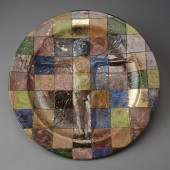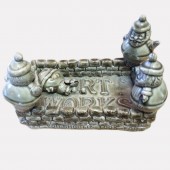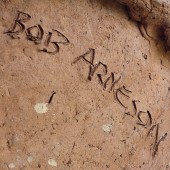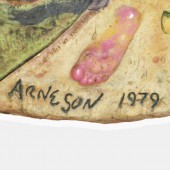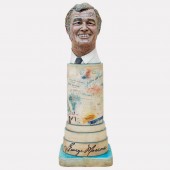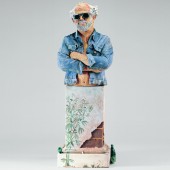![]() Printer version
Printer version
Robert C. Arneson, Robert Arneson
1930 Born, Benicia, California
1992 Died, Benicia, California
EDUCATION
1949-1952 College of Martin, Kentfield, California
1954—BA Art Education California College of Arts and Crafts, Oakland, California
1958—MFA California College of the Arts, Oakland, California
PRIMARY WORK EXPERIENCES
1958-1993 Ceramic Sculptor
1960-1962 Instructor of Design and Crafts, Mills College, Oakland, California
1962-1991 University of California, Davis, California
Robert Arneson is perhaps best known for his ceramic sculptural pieces that challenge social and economic norms and beliefs prevalent in western civilization of his time. He was one of several California ceramists who in the 1960s began to abandon the traditional ceramic vessel in favor of experimenting with the use of clay to express concepts. Everyday items were created in clay to comment on contemporary socio-political issues. He became a leader in a movement that became known as Ceramic Funk, part of the larger Funk Movement that swept through California during the 1960s.
Arneson began his interest in art as a high school student by drawing cartoons and painting with water colors an interest he would pursue throughout his career. His early teaching positions required him to teach ceramics, not a media he had mastered, which led him to take ceramics classes. He enrolled in summer classes with Herbert Sanders at San Jose State and with Edith Heath at California College of Arts and Crafts. In 1957 he enrolled in the MFA program at Mills College where he studied ceramics with Antonio Prieto. There are examples of perfectly thrown pots from this period. Abstract Expressionist ideas began to enter his work in the late 1950s and early 1960s. At this time Arneson was aware of the work of Peter Voulkos whose influence began to appear in Arneson’s sculptures. Ceramic pieces created by Joan Miro with Josep Artigas also interested Arneson.
In 1962 he was hired by The University of California, Davis where at a time when ceramic sculpture was not considered a serious art medium, he established the ceramic sculpture program as part of the larger Art Department.
Drawing was an integral part of his studio work throughout his life: he worked out ceramic sculptures in numerous detailed sketches. He also made many drawings and paintings with other themes including the Alice Street house which he repeatedly painted during 1967-68 while living in New York City. Arneson’s curiosity led him to take classes in other media including weaving and jewelry making. Bronze casting was his major focus in 1963, his goal that year was a casting a week.
Figurative pieces began to show up in his work in the early 1960s, in 1969 he constructed most of the long series of cast trophies. Arneson typically worked in series developing an idea by its repetition.The trophies led to a series of household items each embellished with unexpected elements. Going forward he continued throughout his life to create figurative work including numerous oversized self-portraits and portraits of friends that he had begun making in the early 1970s. In addition to the various written signatures discussed above he often used metal stamps to impress block letter messages as well as his signature and occasionally the date on his pieces.
PUBLIC COLLECTIONS
Aichi Prefectural Ceramic Museum, Seto, Japan
Akron Art Museum, Akron, Ohio
Anderson Collection at Stanford University, Palo Alto, California
Arkansas Art Center, Little Rock, Arkansas
Art Institute of Chicago, Chicago, Illinois
Birmingham Museum of Art, Birmingham, Alabama
Boise Art Museum, Boise, Idaho
Carnegie Museum of Art, Pittsburgh, Pennsylvania
Cleveland Museum of Art, Cleveland, Ohio
Colby College Museum of Art, Waterville, Maine
Cornell Fine Arts Museum, Winter Park, Florida
Crocker Art Museum, Sacramento, California
Davis Art Center, Davis, California
De Cordova Museum and Sculpture Park, Lincoln, Massachusetts
Denver Art Museum, Denver, Colorado
Des Moines Art Center, Des Moines, Ohio
Everson Museum of Art, Syracuse, New York
Fresno Metropolitan Museum of Art. Fresno, California
Fine Arts Museums, San Francisco, California
Henry Art Gallery, University of Washington, Seattle, Washington
Hirshhorn Museum and Sculpture Park, Washington, DC
Honolulu Museum of Art, Honolulu, Hawaii (formerly The Contemporary Museum, Honolulu, Hawaii)
Jewish Museum, New York, New York
Krannert Art Museum, University of Illinois, Champaign-Urbana, Illinois
Laguna Art Museum, Laguna Beach, California
Lannan Foundation, Santa Fe, New Mexico
Lewis Foundation, Richmond, Virginia
Los Angeles County Museum of Art, Los Angeles, California
Lowe Museum of Art, University of Miami, Florida
Maier Museum of Art, Randolph College, Lynchburg, Virginia
Memphis Brooks Museum of Art, Memphis,Tennessee
Metropolitan Museum of Art, New York, New York
Montreal Museum of Decorative Arts, Montreal, Canada
Mildura Arts Center, Mildura, Australia
Mills College Art Museum, Oakland, California
Milwaukee Art Museum, Milwaukee, Wisconsin
Museum of Arts and Design, New York, New York (formerly American Craft Museum, New York)
Museum of Contemporary Art, Chicago, Illinois
Museum of Contemporary Art, Los Angeles, California
Museum of Fine Arts, Boston, Massachusetts
Museum of Fine Arts, Houston, Texas
Museum of Modern Art, New York, New York
Museum of Modern Art, Shiga, Japan
National Museum of Modern Art, Kyoto, Japan
Richard Nelson Gallery and Fine Arts Collection, University of California, Davis, California
Nelson-Atkins Museum of Art, Kansas City, Missouri
Norton Museum of Art, West Palm Beach, Florida
Oakland Museum of California, Oakland, California
Orange County Museum of Art, Newport Beach, California
Oberlin College, Allen Memorial Art Museum, Oberlin, Ohio
Palm Springs Desert Museum, Palm Springs, California
Pennsylvania State University, Palmer Museum of Art, University Park, Pennsylvania
Philadelphia Museum of Art, Philadelphia, Pennsylvania
Phillips Collection, Washington, DC
Phoenix Art Museum, Phoenix, Arizona
Pollock-Krasner Study Center, East Hampton, New York
Racine Art Museum, Racine, Wisconsin
Renwick Gallery, Smithsonian American Art Museum, Washington, DC
Rhode Island School of Design Museum, Rhode Island School of Design, Providence, Rhode Island
San Francisco Museum of Modern Art, San Francisco, California
San Jose Museum of Art, San Jose, California
Santa Barbara Museum of Art, Santa Barbara, California
Seattle Art Museum, Seattle, Washington
Shigaraki Ceramic Cultural Park, Shigaraki, Japan
Spencer Museum of Art, University of Kansas, Lawrence, Kansas
St.Louis Art Museum, St. Louis, Missouri
Stedelijk Museum, Amsterdam, The Netherlands
Toledo Museum of Art, Toledo, Ohio
University of Iowa, Museum of Art, Iowa City, Iowa
University of California, Berkeley Art Museum, Berkley, California
University of California, Davis, California
University of New Mexico, Albuquerque, New Mexico
University of Utah, Utah Museum of Fine Arts, Salt Lake City, Utah
Wadsworth Atheneum, Hartford, Connecticut
Frederick Weisman Art Foundation, Malibu, California
Whitney Museum of American Art, New York, New York
Wright State University, Dayton, Ohio
Yale University Art Gallery, New Haven, Connecticut
BIBLIOGRAPHY
Adrian, Dennis. “Robert Arneson’s Feats of Clay”. Art in America (September - October 1974).
Arneson, Robert. “Guardians: The Spirit of the Work”. Ceramics Monthly (April 1991).
Berkson, Bill. Robert Arneson: Double Portraits. San Francisco, CA: Brian Gross Fine Art, 1999.
Benezra, Neal. Robert Arneson: A Retrospective. Des Moines, IA: Des Moines Art Center, 1986.
Fineberg, Jonathan. A Troublesome Subject: The Art of Robert Arneson. Berkeley, CA, Los Angeles, CA, London, England: University of California Press, 2013.
_______________, Gary Garrels, and Janet Bishop. Robert Arneson: Self Reflections. San Francisco, CA: San Francisco Museum of Modern Art, 1997.
Johnson, Ken. “Robert Arneson at Frumkin/Adams Gallery”. Art in America (December 1990).
Kramer, Hilton. “Ceramic Sculpture and the Taste of California”. The New York Times, 20 December 1981.
Kuspit, Donald. “Arneson’s Outrage”. Art in America (May 1985).
____________. “Robert Arneson”. Artforum (January 1991).
Mayfield, Signe, Daniel Rosenfeld, and Linda Craighead. Big Idea: The Maquettes of Robert Arneson. Palo Alto, CA: Palo Alto Art Center, 2001.
Mazow, Leo. Arneson and the Object. University Park, PA: Palmer Art Museum, 2004.
Morinue, Camille and Lucia Pesapane. Ceramix, from Rodin to Schutte. Belgium Snoeck Publilshers, 2015.
Nash, Steven A. Arneson and Politics: A Commemorative Exhibition. San Francisco, CA: Fine Arts Museums of San Francisco, 1993.
Natsoulas, John. Thirty Years of tB-9: A Tribute to Robert Arneson. Davis, CA: John Natsoulas Gallery, 1991.
Propokoff, Stephen and Suzanne Foley. Robert Arneson. Chicago, IL: Museum of Contemporary Art, 1974.
Selz, Peter. Funk. Berkeley, CA, University Art Museum, 1967.
Sommer, Robert. “Comment: Arneson’s Bust”. Arts and Architecture (August 1982).
Tarshis, Jerome. “Looking for Arneson to Get Serious”. California Magazine (May 1985).
CV or RESUME: Click Here to Download
CV or RESUME: Click Here to Download
Source: Elaine Levin Archives, University of Southern California
Marks: Inscribed "Robert" or "Arneson" in wet clay either in cursive or print, or with underglaze pencil or permanent marker, or stamped in clay or other material with metal dies, carved name as on the bricks, used a bamboo tool to inscribe in wet china paint. Signature: Early pieces were signed on the bottom; objects signed in various places as on the front of the spacer bar on "Typewriter," 1965; self portraits and portraits of others usually on the back of the neck, with date; small trophy busts were stamped on front with date on bottom; masks were usually signed on the back either incised in the clay or with an underglaze pencil. There were many variations: "Smorgi-Bob," 1971, is stamped on the chef’s jacket as a name tag; "Captain Ace," 1978, is stamped on the front of the bomber jacket on lower right side; "Casualty in the Art Realm," 1979, a large floor piece is signed and dated near the the right foot with a bamboo tool; "Nasal Flat," 1981, is inscribed on the right side of the back of the neck; "California Artist," 1982, is stamped on the “denim” tab on bottom of jacket on the back. (From Sandra Shannonhouse, January 2016)
Materials: Terracotta
Method: Press Mold, Hand-Built (Individual bricks were press molded then mortared together.)
Citation: "The Marks Project." Last modified June 8, 2017. http://www.themarksproject.org:443/marks/arneson


